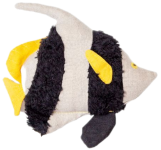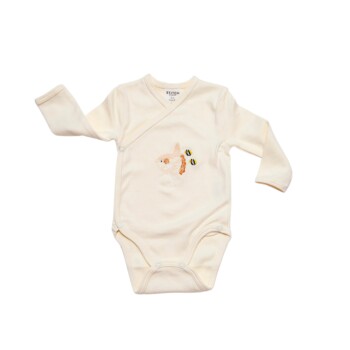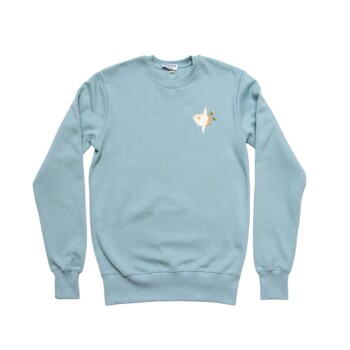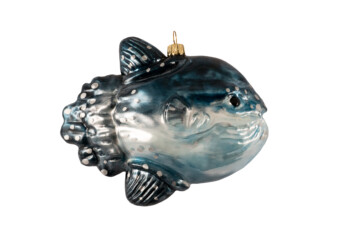Source: Maureen Steenks
Meet Mola Mola ‘The sunfish of Ameland‘
He is 198 centimeters long, 184 centimeters wide and weighs about 400 kilos! We are talking about the sunfish that washed up on Ameland December 14, 2021.
Nature! It always inspires!
The Naturalis Biodiversity Center in Leiden is all about the fascination for biodiversity. The prize-winning museum* shows the beauty of nature, Naturalis does that with the LiveScience room, among other things. With its large windows facing the street, this room is literally and figuratively the showcase of Naturalis. Here you will meet the researchers and collection managers of the museum so that you can see and experience what is involved in their work. Also featured in the LiveScience room is Mola Mola, one of the largest angelfish of all time. The special appearance of Mola Mola provides enough inspiration for the design team of the Naturalis museum shop. That is why Naturalis has designed a baby and children’s clothing line with Mola Mola together with the Amsterdam Embroidery label Stitch Amsterdam. In addition, there is a line of cuddly toys inspired by the large sunfish and exclusively designed and handmade by the Dutch label Kaplum. Available via the Naturalis museum shop.
*(BankGiro Loterij Museum Prize 2020 and European Museum of the Year 2021)
MEET MOLA MOLA
He is 198 centimeters long, 184 centimeters wide and weighs about 400 kilos! This makes this angelfish not the largest of all time, but it is the largest in a long time. The largest sunfish was already and can still be seen in the Naturalis LiveScience room. After the Moonfish unfortunately died on the beach of Ameland, Naturalis admitted the animal for research. Not much is known about angelfish yet, so the research institute seized this opportunity to learn more about, among other things, the parasites on the skin of the angelfish. Naturalis is interested in all biodiversity. The eating pattern of the sunfish was examined on the basis of the contents of the stomach and intestine. The design work of the Moonfish and the making of a 3D scan could be followed live at Naturalis in the LiveScience room and via a live stream, where interested parties could follow the scientific work. During the preparation of the sunfish, it was discovered that the fish probably always had only one fin, just like Nemo in the cartoon. Mola Mola is thus affectionately called Nemo. It is the first time since 1940 that Naturalis has put a sunfish on again. The Ameland sunfish has now been given a place in the Naturalis collection tower.
Because it is so special that Naturalis has set up a Moonfish again for such a long time, the design team of the Naturalis museum shop was inspired by Mola Mola.
NATURALIS X STICH AMSTERDAM
Stitch Amsterdam is a creative embroidery studio and clothing brand, founded in 2020 by Lonneke van Kuijeren who wanted to see more quirkyness in sustainable clothing. All Stitch Amsterdam products are produced on demand in the studio in Haarlem. Stitch Amsterdam embraces the slow-fashion movement and uses only organic materials and sustainable products. Embroidery is one of the oldest art forms and Stitch Amsterdam appreciates that art in a modern way. Stitch Amsterdam uses high-quality Madeira thread, which can withstand washing at 95°C.
KAPLUM FOR NATURALIS
The designer duo Anna van Gerve and Alper Demir van Kaplum make playful and imaginative toys for little explorers. The way children experience the world – full of colour, fantasy and adventure – forms the basis for their designs. Exclusively for Naturalis, Kaplum designed colorful and handmade Mola Mola cuddly toys in two sizes and a cuddly toy of the bannerfish, a friend of Mola Mola who keeps his skin clean. All our products are designed and handmade in their home studios in Alkmaar and contain 0% plastic and are 100% natural.
THE BEST MOLA MOLA FACTS
Millstone
Mola is the Latin word for millstone. It refers to the shape of the fish. A millstone formerly used to grind grains is a robust, flattened stone. Because the sunfish only seems to consist of a head, a striking comparison.
300 million eggs
Angelfish are large fish that live in all oceans. They have surprising properties. Mother sunfish, for example, lays up to 300 million eggs at a time. That is almost 20 times as many as the number of people living in the Netherlands. With that amount she breaks all records. Because there is no other vertebrate known that produces so many eggs.
Sun or Moon?
In Dutch the sunfish is called moonfish. But its English name is: sunfish. What is it, sun or moon? Actually, sunfish is very well found. For the sunfish is a sun worshiper. He likes to float on his side on the surface, then it looks like he is sunbathing. Researchers have several explanations for why the animal does this. In the first place it is known that the sunfish is a favorite host for all kinds of parasites and other fish such as the bannerfish. At the sea surface, birds could easily give it a cleaning. Another possible function of sunbathing is warming.
Tasteless Menu
What the sunfish likes is as strange as its appearance. Adult angelfish live mainly on jellyfish, which they hunt at great depths. What’s the flavor in that? If you know that jellyfish consist of 95 percent water, you also wonder how the sunfish can survive on such a menu. Young angelfish eat more varied. For example, they live on sponges, crustaceans, sea grass and small fish.






